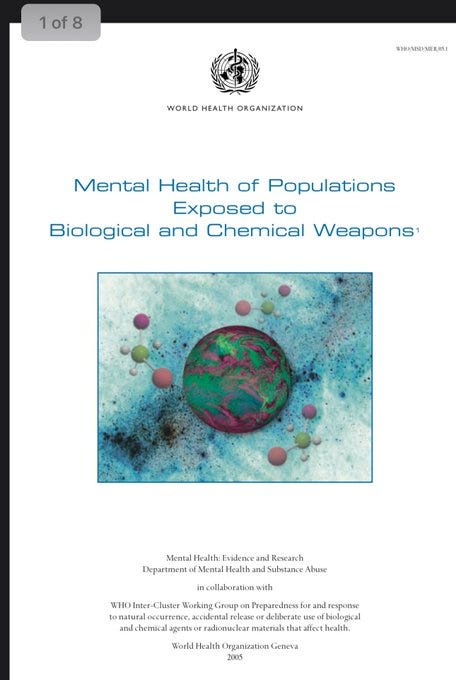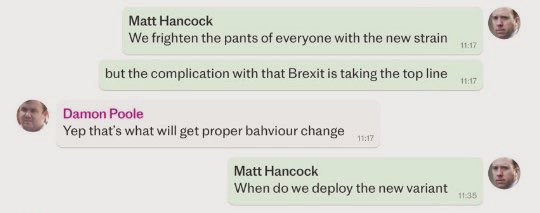Did the Declaration of a Pandemic Cause Mass Psychogenic Illness?
How terrifying the populace can cause harm
In 2006 the Department of Homeland Security produced a report looking at whether the Fear of Terrorist Attack Could Trigger Mass Psychogenic Illness.
But what is a Mass Psychogenic Illness (MPI)? The document defines it as “a phenomenon in which social trauma or anxiety combines with a suspicious event to produce psychosomatic symptoms, such as nausea, difficulty breathing, and paralysis. If many individuals come to believe that the psychosomatic outbreak is connected to the cause of the trauma or anxiety, these symptoms can spread rapidly throughout a population”.
A bit like a virus.
The report looks at a number of examples of MPI from around the world including one in December 2005 in Chechnya. 13 school children fell ill with a mysterious illness marked by headaches, fever, faintness and numbness in extremities. Rumours quickly spread that the illness was caused by a Russian chemical weapons attack. No evidence has ever been produced to suggest there was an attack but, once the rumours had started, similar symptoms spread throughout the region.
Medical officials have since determined that the spread of illness was a case of psychosomatic contagion or MPI due to residents being anxious over Russian military activity in the area. In total, 87 people (mainly children) were hospitalised.
Another incident occurred in California in 2003 where a man entered a bank and sprayed an aerosol can in the air before leaving. Very quickly, the bank employees and customers became ill with similar symptoms to the Chechen case above.
After an investigation, it was determined that no chemical or biological agents were used and the symptoms may have been psychosomatic.
The report also looked at a sarin gas attack in the Tokyo subway in 1995. Even though the attack was relatively confined, over 5,000 people flooded more than 260 medical facilities in the area seeking treatment for exposure.
After looking at the case studies the report recommended that MPI should be taken into account when planning and executing incident response. This is because symptoms of MPI can resemble non-specific symptoms of possible chemical and biological weapons - including chemical agents, inhalational anthrax and avian influenza. (emphasis my own)
The recommendations given were to incorporate plans to handle psychogenic illness into incident response plans.
Both the CDC and the WHO made a number of recommendations to alleviate the effects of MPI, including isolating individuals and reassuring the public. The report also referenced a WHO report called “Mental Health of Populations Exposed to Biological and Chemical Weapons”.
The experience of fear in biological and chemical warfare
Exposure to disasters or warfare is frightening to most persons. However, fear is even more likely when biological and chemical agents are involved. First, the most intimidating and terrifying component of biological and chemical warfare is that invisible agents are involved. In an explosion, people know immediately whether or not they have been injured. However, during biological warfare, people generally cannot rely on their own senses to determine physical exposure.
Second, fear and helplessness is increased when the agent can be spread by person-to-person contact creating a situation in which health providers, family, friends, and neighbours may be sources of illness. As a result, safe health care and social support may not be readily available at a time when they are needed most. The use of an agent that is contagious induces distressing problems, such as social stigma, isolation, and quarantine, including the separation of children from their parents, and fear of infecting loved ones. A chemically contaminated area may lead to the distressing experience of evacuation.
Third, the uncertainty of the extent of dangerousness of biological and chemical weapons enhances fear. Because many agents are rarely encountered, there may be a lack of clarity among professionals about who is at risk of infection, how to reliably detect cases (generating myriad of ‘false positive’ assessments), what the health consequences might be, and how to manage the crisis. The expression of conflicting expert opinions and changing public health recommendations are likely to enhance public anxiety.
Fourth, persons may misattribute signs of autonomic arousal as evidence of infection or contamination. Sign and symptoms of autonomic arousal are normal among frightened persons and involve various systems and organs and include muscle tension, palpitations, hyperventilation, vomiting, sweating, tremors, and a sense of foreboding. Thus frightened, physically healthy individuals experiencing symptoms of autonomic arousal may mistakenly attribute the physical sensations to infection or contamination and may overwhelm health services.
Fifth, persons wearing protective clothing, masks, and respirators may experience great distress due to: heat and breathing stress, claustrophobic effects (so-called gas mask phobia), potential impairment in verbal communication, and reduction in physical functioning to perform tasks perceived to be necessary for survival.
Despite high public fear and uncertainty, historical accounts of chemical and biological attacks suggest that public panic is rare. Public panic occurs only when there are inadequate exits in confined places (e.g., in stadiums) or perceptions of limited access to essential, life-saving health services.
However, that rare public panic became common place. Pandemic planners knew what fear could do to a population but instead of trying to quell it, they introduced more and more draconian measures, exacerbating the panic. It’s almost as if they knew what they were doing to prolong a pandemic. Just in time for a miracle in the form of saviour vaccines to occur.
Reading the reports above shows that the response to the pandemic was the exact opposite of what should have happened to ensure MPI didn’t occur. It’s almost as if somebody went through the check list to ensure maximum fear was achieved. Isolation - check. Masks - check. Uncertainty - check. Constantly changing rules and ‘expert’ advice - check.
I wonder how many people were hospitalised and died due to MPI? How many of those people tested positive for Covid even though it may not have been the source of their illness? How many of those people even had Covid? Perhaps an oversensitive PCR test meant they were left isolated, given damaging medication, denied treatment or put on a ventilator when they were just displaying symptoms of MPI due to panic and fear.







The real virus is the government and media sponsored fear mind virus.
I have now come to the realisation that the real terrorists amongst us are our own governments. Well dressed, well spoken but terrorists nonetheless they have used unlawful violence in the form of induced fear, panic and intimidation against civilians - the very definition of terrorism.